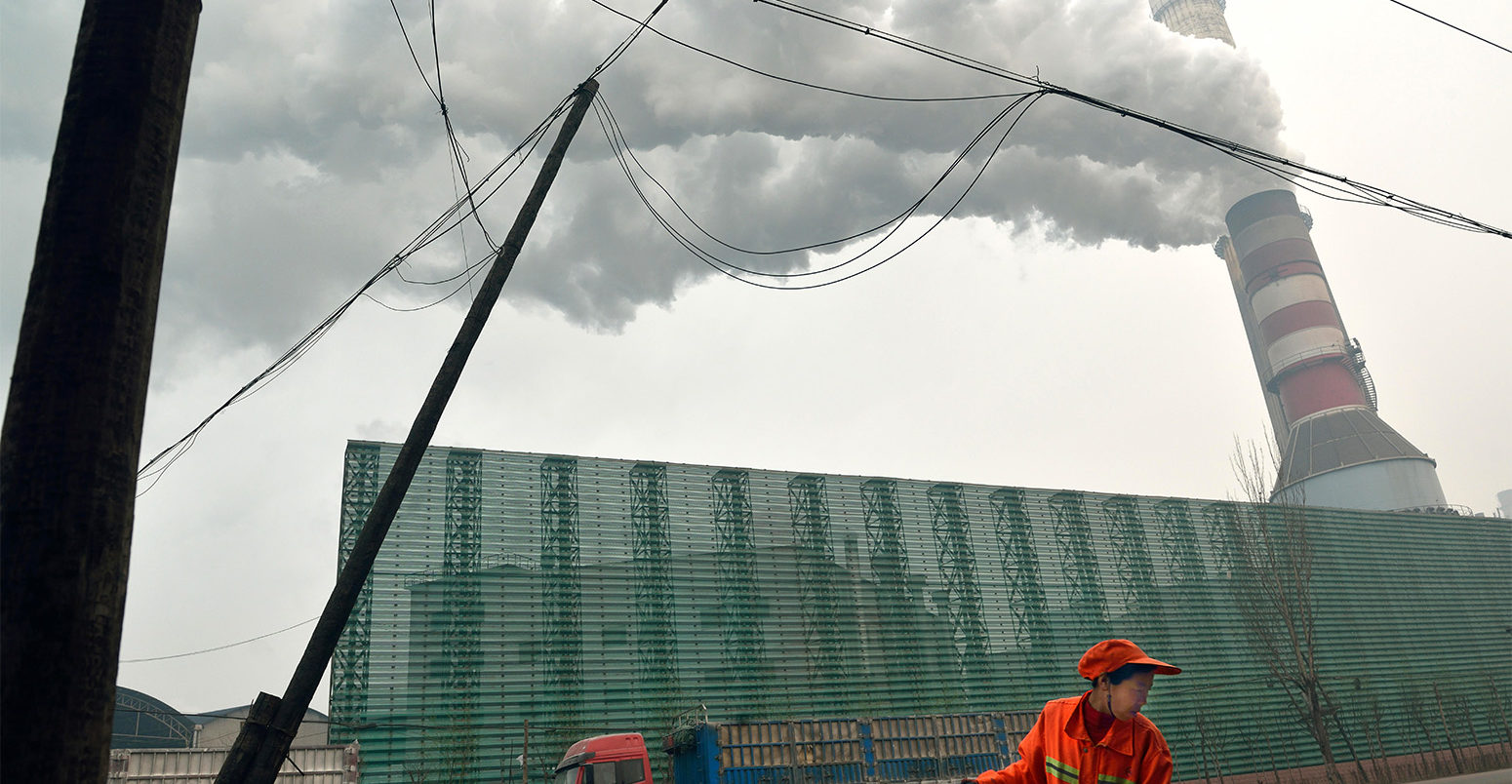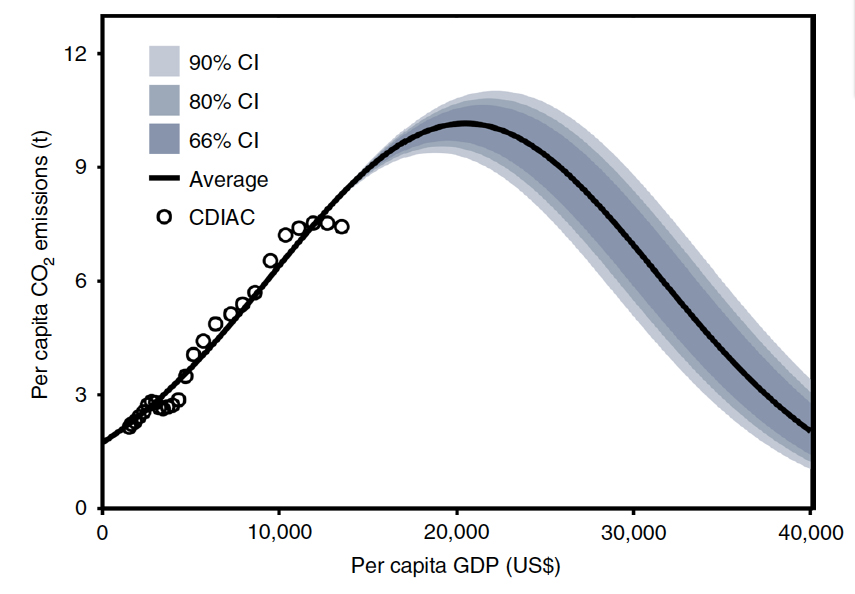
China’s emissions ‘could peak 10 years earlier than Paris climate pledge’
Josh Gabbatiss
07.29.19Josh Gabbatiss
29.07.2019 | 4:00pmCO2 emissions in China may peak up to a decade earlier than the nation has pledged under the Paris Agreement, according to a new study.

With its enormous population and heavy reliance on coal, China is by far the world’s biggest polluter, responsible for more emissions than the US and EU combined.
One of the drivers behind Chinese emissions is the intense urbanisation that has taken place across the country in recent years, as millions of people flock from rural areas to rapidly expanding cities.
However, in new analysis published in Nature Sustainability, a team of researchers has shown that as China’s burgeoning cities become wealthier, their per capita emissions begin to drop.
According to their analysis, this trend could in turn trigger an overall dip in CO2 levels across the nation, and mean that despite the current target for emissions peaking by 2030, they may in fact level out at some point between 2021 and 2025.
It is not the first time a study has suggested a premature dip in China’s emissions, but its timing is significant given an imminent UN summit where world leaders will under pressure to step up their Paris targets.
City living
By 2010, nearly half the Chinese population were city dwellers, and another 280 million formerly rural people are expected to make the jump by 2025.
Urban populations make an outsized contribution to climate change, consuming on average nearly three times as much energy as those in the countryside. This makes such a demographic shift all the more significant.
While some efforts are underway in China to cut individual cities’ emissions, the authors of the new paper say this can be challenging due to lack of data.
In their paper, they have determined carbon emissions from 50 Chinese cities, including at least one from every province apart from Tibet, over a 17 year period from 2000 to 2016. Together, they estimated these cities were responsible for roughly a third of the nation’s emissions in 2015.
To produce CO2 inventories for each city, the team focuses on emissions from energy consumption and industrial processes such as cement and steel production, taking data from statistical yearbooks available for each city to make their calculations.
Ranging from relatively small population centres to the massive megalopolises found on the nation’s east coast, their sample contained a large variety of locations. However, as lead author Dr Haikun Wang from Nanjing University tells Carbon Brief, some broad trends can be identified:
“Industries are currently the major sources of emissions in Chinese cities, which is very different from the cities of developed countries. Emissions of transportation and buildings are growing rapidly when the cities become wealthier.”
Turning point
The researchers found that for the cities they sampled, they could project the relationship between per capita emissions and per capita GDP as a bell-shaped curve known as a “Kuznets curve”. Essentially, as cities become richer, their emissions per capita begin to level out and decline.
This trend has already been seen in some of the nation’s largest cities, such as Beijing, which saw its emissions peak at 9 tonnes of CO2 per capita around 2007. While the researchers say each city’s emissions peak will be different, their results suggest they will take place once per capita GDP reaches around US$21,000 [see figure below].
There is currently no consensus about when China as a whole will reach its national turning point, but Wang and his colleague suggest that as their 50 cities display “very different characteristics and growth rates”, they offer a reasonable representative sample of the country.
The researchers therefore suggest that China’s national turning point for per capita emissions will be roughly the same as the one they established for cities.
Using data on future population size and level of economic development from the World Bank, they “optimistically” suggest that the nation’s total emissions will therefore peak at 13-16 gigatonnes of CO2, which should take place between 2021 and 2025. Wang explains:
“This reflects China’s great efforts in mitigating climate change and the ‘new normal’ of [the] economy, which would be a great contribution of China to ensure the Paris Agreement to limit global warming to 2C or less by the end of the century.”
He says the results show how Chinese cities are “paying more attention” to environmental problems, including both greenhouse gas emissions and air pollution, as they become wealthier. The “new normal” – a term initially used by Chinese premier Xi Jinping in 2014 – refers to the slower rate of economic growth expected in the years following the 2007-2009 financial crisis.

Leaking carbon
While the results are good news for anyone hoping the world will hit its most ambitious climate targets, they are not the last word on the topic.
Dr Jan Ivar Korsbakken, a climate economics expert at the CICERO Center for International Climate Research, explains that while the analysis is “convincing when read on its own terms”, it should “not be read as a definitive projection” for China’s peak emissions. He tells Carbon Brief:
“It’s a statistical estimate based on historical data for how developments in emissions and economic wealth have correlated over time in 50 of China’s main cities. Other estimates using other data sets or other estimation techniques could give different results. You need to look at many such analyses and triangulate.”
Korsbakken points out that the analysis is based on some assumptions that come with important caveats.
Firstly, the large cities in the study that have already managed to reverse their emissions growth have done so by cutting down on heavy industry and power generation within their city limits. However, this means they have to import more industrial products and electricity from elsewhere, as Korsbakken explains:
“All cities can’t do that. At some point, you run out of places to move the heavy industry and power plants to. They could potentially move much of their industrial production abroad and import the products, but then emissions would need to go up in some other countries.”
This problem is acknowledged by Wang and his co-authors in their study, where they note that wealthier cities in the east might be tempted to relocate their emissions elsewhere. They suggest policies ought to be put in place to discourage such “carbon leakage”, and that western Chinese cities must take advantage of their “abundant renewable energy”.
Another potentially disruptive factor is the uncertainty around China’s future economy, which the paper assumes will play out according to the government’s plans. According to Korsbakken, who has previously co-authored articles for Carbon Brief on China’s annual emissions and economy, “given the current economic turmoil, that is a tall assumption”.
There are already signs of an economic slowdown in China, potentially hastened by the on-going trade war with the US. While the effects of this stagnation are hard to predict, it could lead to more government investment in emissions-intensive infrastructure, or hold back the GDP growth Wang and his team have linked with emissions reductions.
At the same time, Korsbakken notes that such developments could also encourage Chinese leaders to invest in energy efficiency and shift growth to less carbon-intensive sectors.
To ensure that some of the less developed cities have low-emissions futures ahead of them, the study authors say emphasis must be placed on sustainable growth principles as they are constructed. This way, they say these emerging population hubs will be able to “leapfrog” carbon intensive growth altogether.
Make or break
While there is still uncertainty about the exact timing, Wang and his team are not the first to suggest China will beat its current pledge under the Paris Agreement.
Carbon Brief’s own analysis in 2015 looked at the superpower’s intended nationally determined contribution and found that at the top end of the strategy it could see CO2 peaking in 2027.
Another analysis, conducted by Prof Lord Nicholas Stern and Fergus Green at the London School of Economics in 2016, argued CO2 emissions from energy in China are likely to peak “at some point in the decade before 2025”.
In a statement on the new study sent to Carbon Brief, Lord Stern, who is chair of the Grantham Research Institute on Climate Change and the Environment, says:
“There are a number of indications that China’s annual emissions of CO2 and other greenhouse gases have already plateaued. Although they have levelled off, there are still some year to year fluctuations.”
The paper comes at a crucial diplomatic moment, as nations gear up for UN secretary general António Guterres’ “Climate Action Summit”, which is taking place in New York in September.
There, nations are expected to come forward with “concrete, realistic plans to enhance their nationally determined contributions by 2020”. Guterres has called for these plans to be in line with a 45% cut in emissions over the next decade, and net-zero emissions by 2050, following the most recent evidence from the Intergovernmental Panel on Climate Change on limiting warming to 1.5C.
Jennifer Tollmann from green thinktank E3G says that as the world’s largest emitter, China’s peaking date can “make or break global efforts to avert the most catastrophic effects of climate change”. Responding to the Nature Sustainability paper, she tells Carbon Brief:
“Studies like this show that for China higher emissions reduction targets are absolutely achievable. With the UN secretary general’s Climate Action Summit just around the corner, this should give China even more confidence in its ability to do more, faster.”
She suggests a cap on new coal infrastructure built after 2020 – as already advocated by Guterres – and a phase-out of China’s international coal finance as examples of “concrete actions” the nation could take. (In contrast, China’s electricity industry is lobbying for an even greater number of coal-fired power stations to be built.)
After a G20 summit in June that was marred by US opposition to climate discussions, China and France issued a joint statement together with Guterres pledging to increase their targets. The move was seen as an important signal that China intends to take a climate leadership role and introduce stringent new targets next year.
Despite its great leaps in renewable energy, Korsbakken thinks so far China’s efforts to cut emissions have been more about pragmatism than climate leadership. He says major cuts to greenhouse gases have been welcome co-benefits resulting from efforts to reduce air pollution in cities, expanding service and hi-tech industries, and diversifying the energy mix:
“That being said, China will soon need to start looking beyond just actions that have major co-benefits. China needs to do a lot more if we are to have any hope of reaching the goals in the Paris Agreement. The same can be said for pretty much every other country, too.”
Wang, H. et al. (2019) China’s CO2 peak before 2030 implied from characteristics and growth of cities, Nature Sustainability, https://doi.org/10.1038/s41893-019-0339-6
-
China’s emissions ‘could peak 10 years earlier than Paris climate pledge’
-
China’s emissions ‘could peak 10 years early’ as cities become wealthier

